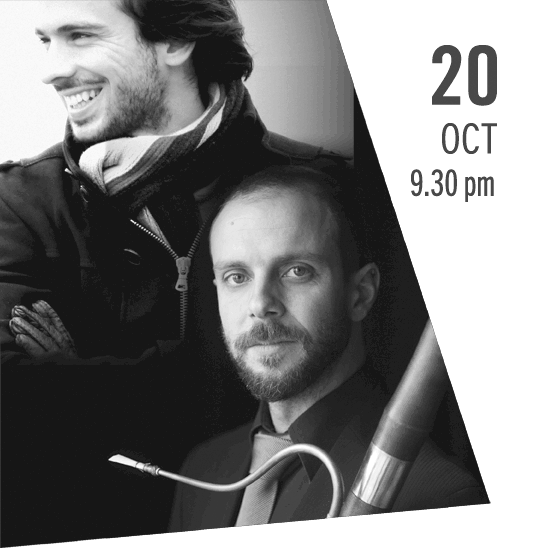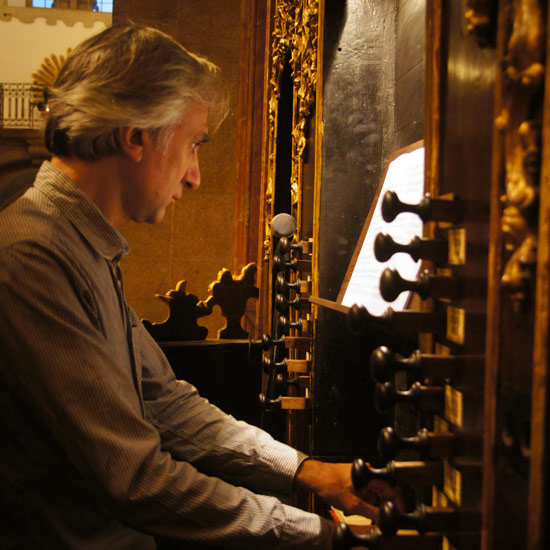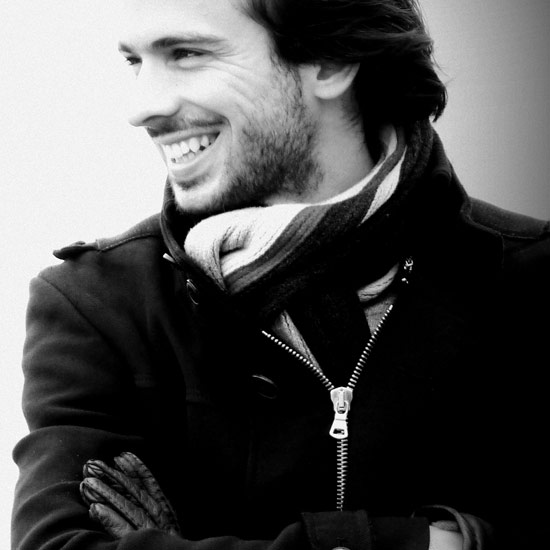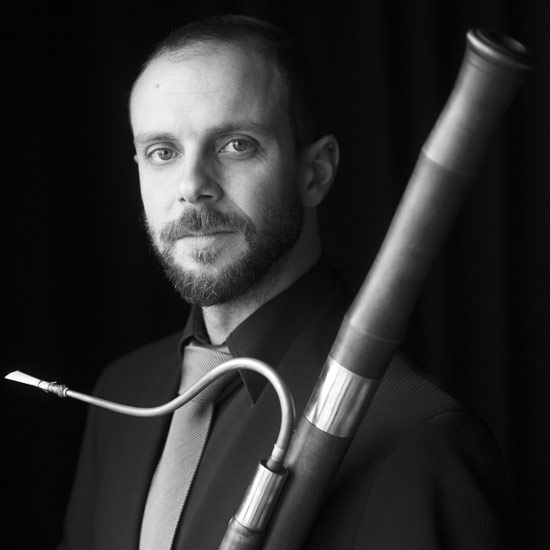 October 20, Friday, 9.30 pm;
October 20, Friday, 9.30 pm;
Igreja de São Martinho · Funchal;
DANCERIES
Dance in European music around 1600
João Vaz, organ;
Tiago Simas Freire, cornett;
José Gomes, dulcian;
Let us make the organ dance with two of its greatest allies from the beginning of the seventeenth century – this is the challenge of the present programme. In parallel with the organ, the instruments that around 1600 became practically obligatory in the main Iberian chapels and cathedrals were without doubt the cornetto and the dulcian – the first a high voice, the second low. These instruments completed and/or replaced the old consort of reeds and sackbuts, typical since the 15th century. As Paulo Estudante points out in his thesis (2007), though we have testimony of the presence of the cornetto and the dulcian in Spanish cathedrals from the middle of the 16th century, the first Portuguese records seem to be somewhat late. The ensemble of 1593 at the Cathedral of Évora is the first to include a cornetto. At Coimbra, the instrument appears only in 1609. Employed mainly to double and/or replace the soprano voices, the cornetto continued to be used in Portuguese cathedrals until at least the first half of the eighteenth century (Coimbra, 1703; Évora, c.1725). The dulcian, a precursor of the current bassoon, developed a role as a bridge between the singers and the instrumentalists. In addition to playing with the instrumental group, it was also a regular participant in the singers’ group, reinforcing or replacing the low voice. With its acoustical tube bent in two, it is able to reach then lower range, maintaining good flexibility since its dimensions are much smaller than the equivalent instruments of other families. The dulcian was sometimes admitted into ecclesiastical establishment before a complete instrumental group and, like the cornetto, was assimilated by Spanish institutions in the second half of the sixteenth century. In Portugal, the first record of a paid dulcian player is found in Évora, one João de Contreiras (1572). In Braga, the master instrumentalist of the Cathedral, Pero Gomes Franquo, played the dulcian every Sunday, holy day and at solemn vespers, at least already in 1592. In the centre of the country, at the Cathedral of Coimbra, the first reference to the dulcian comes from the instrumentalist Manuel de Moura, in 1609. 1609 seems a little late, especially if one considers the neighbouring institution, the Monastery of the Holy Cross in Coimbra. Here, already in 1590, and very probably after an experimental period, those in charge of the Order authorized the use in its various houses, including the mother-house of the Holy Cross, of the dulcian in its liturgical services. Today a programme dedicated to dances intended for three instruments typical of liturgical use may seem curious, but in truth, both these instruments were greatly used both in the secular sphere as dance music just as secular music assumed greater freedom and pre-eminence in religious functions. Thus we explore the permeable fringes of the sacred and secular workds by means of the ambivalence and omnipresence of dance music in various musical worlds around 1600. From Portugal to Germany, from Italy to the Low Countries, passing through France, we present this programme of dances, courtly, theatrical, ecclesiastical and also dances which served as the basis of new musical genres.
Tiago Simas Freire
Program
DANCERIES – DANCE IN EUROPEAN MUSIC AROUND 1600
CLAUDIO MONTEVERDI (1567-1643)
Toccata e La Moresca
(L'Orfeo, 1609)
ANTONIO VALENTE (c.1565-1608)
Lo ballo dell'intorcia *
(Intavolatura di cimbalo, 1576)
DIEGO ORTIZ (c.1510-c.1576)
Recercada sobre «Passamezzo antico»
(Libro secondo, 1553)
ANTONIO DE CABEZÓN (1510-1566)
Pavana con su glosa *
(Libro de cifra nueva, 1557)
MICHAEL PRAETORIUS (1571-1621)
Ballet de la comédie
(Terpsichore, 1612)
Diego Ortiz (c.1510-c.1576)
Recercada sobre «La Folia»
(Libro secondo, 1553)
ANDREA FALCONIERO (1585/6 – 1656)
Passacalle
(Primo libro de canzone, 1650)
BERNARDO PASQUINI (1637-1710)
Partite sopra l’aria della folia da Spagna *
(Ms. 964, Arquivo Distrital de Braga)
ANÓNIMO (Santa Cruz de Coimbra, c.1650)
Tarambote
(Cartapácios de Coimbra, BGUC)
ANÓNIMO (Itália, séc. XVII)
Aria [Bergamasca] con variationi *
(Ms. 964, Arquivo Distrital de Braga)
NICOLAS LE BÈGUE (1631-1702)
Ou s'en vont ces gays bergers
(Troisième livre d'orgue, c.1685)
CLAUDE GERVAISE (1525-1583)
Pavane
Gaillarde
Tourdion
(Livres de danceries, 1547-1557)
 João Vaz
João Vaz
Born in Lisbon, João Vaz graduated in organ from the Higher School of Music in Lisbon, under Antoine Sibertein-Blanc, and from the Higher Conservatoire of Music of Aragon in Zaragoza, where he studied with José Luis González Uriol, on a grant from the Gulbenkian Foundation. He also holds a doctorate in music and musicology from the University of Évora, with a thesis, supervised by Rui Vieira Nery, on Portuguese organ music at the end of the Ancien Regime. He has been highly active internationally, both as a performer and as a teacher on courses or member of the jury of performance competitions. He has made over ten solo recordings, significant among them being those made on Portuguese organs. He currently teaches organ at the Higher School of Music in Lisbon and is artistic director of the Madeira Organ Festival and the series of concerts which are given on the six organs of the National Palace of Mafra (to whose restoration he was a permanent consultant) and of the historical organ of the Church of S. Vicente de Fora, in Lisbon (of which he became titular organist in 1997.) in 2017 he was awarded the Medal of Honour of the Municipality of Mafra.
 Tiago Simas Freire
Tiago Simas Freire
Tiago Simas Freire holds a doctorate in music and musicology (University of Coimbra, University of Lyon, CNSMDL) and three masters: recorder, historical cornetto (CMSD Lyon) and architecture (IST Lisbon). Active flautist and cornettist, he appears regularly in concert, with Concerto Soave, Akadêmia, Les Meslanges, Le Concert Brisé and Il Gusto Barroco, having recorded for the Harmonia Mundi, Ricercar, SWR2 and Psalmus labels. He has been a researcher at the University of Coimbra (CECH) since 2012 and was a research assistant at the HEM in Geneva between 2016 and 2022. He is teacher of recorder and history of ornamentation at the CNSMD of Lyon. He has worked for the introduction of the practice of historical cornetto at the Higher Schools of Music of Lisbon and Oporto since 2014. He has been invited to teach at seminars at the Centre de Musique Baroque de Versailles, the CCR d’Ambronay, the Fondation Royaumont, the CRR and CNSMD of Paris, the Royal Conservatoire of Brussels and the Conservatoires of Aveiro, Coimbra e Loulé. He founded and directs the Capella Sanctae Crucis, a laboratory for musical research and practice dedicated to unpublished Portuguese sources from the 16th and 17th centuries.
 José Gomes
José Gomes
José Rodrigues Gomes studied musicology, recorder and historical bassoon in Portugal and the Netherlands, concentrating on his investigation into the presence of the basso continuo in Portugal in the 17th and 18th centuries. He appears regularly in concert with various groups and under the direction of musicians of renown in the international field of historically informed performance. He is a member of the Cappella Sanctae Crucis, under the direction of Tiago Simas Freire and principal bassoonist of the Casa da Música Baroque Orchestra under the direction of Laurence Cummings. He teaches historical bassoon at the Higher School of Music and the Arts of the Spectacle at the Royal Conservatoire of Brussels and at the Music-Word-Dance Academy in Jette (Brusels). He has participated in a series of workshops entitled “Conscious Performance”, exploring various extra-musical aspects of performance, having recourse to techniques and tools in the areas of mindfulness and life-coaching. As a performer, he aims to place technical and aesthetic excellence in the service of music, believing that this will take us beyond our daily habits and patterns and bring us to an essential and universal dimension of all things, permitting a communion with everything that surrounds us.
